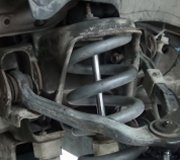First of all, if it's really cold where you are, what you're experiencing might be normal. Rubber bushings get real hard and don't cushion road shock well. The oil in the struts will get thick and the struts won't compress easily when a tire hits a bump.
Another thing to look at is some people loosen control arm bushings when they replace struts. It is important to have the car sitting at proper ride height before those bushings are tightened. If the car is jacked up and the suspension is hanging down, tightening the bolts that way will clamp the bushings in that position, then when the car is lowered to the ground, they will be clamped in a permanent twist. That can apply to other bushings as well.
Can I assume you installed some version of a "Quick Strut" since you replaced the springs too? If you bought the parts separately and put them together, there should have been a rubber bump stop on the shaft of the strut. The symptom will be different than what you described if they're missing, but it's worth mentioning.
Did you get a printout of the alignment? I'd like to see the numbers for "camber", "total toe", and "steering axis inclination", (SAI). All that's important with SAI is it must be the same on both sides, within about 0.2 degrees. I doubt that is wrong because, again, you'd be describing something different.
Total toe is what I'm most interested in. That has to do with the direction the front wheels are steering. If it is wrong, the car can tend to dart from side to side when one tire hits a bump and momentarily has more weight on it than the other one. That will be more pronounced when the tires are able to slip on snow or deep water. Hitting a bump results in an exaggerated response from the car as it tries to follow that one tire.
Friday, February 20th, 2015 AT 4:14 PM


